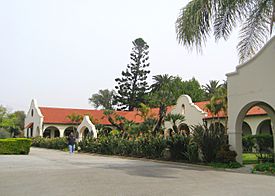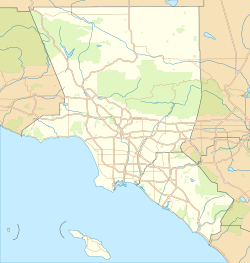Dominguez Rancho Adobe facts for kids
Quick facts for kids |
|
|
Dominguez Rancho Adobe
|
|
 |
|
| Location | 18127 S. Alameda St. Compton, California |
|---|---|
| NRHP reference No. | 76000486 |
| Added to NRHP | May 28, 1976 |
The Dominguez Rancho Adobe is a very old and important house in California. It is California Historical Landmark Number 152. In 1976, it was added to the National Register of Historic Places. This means it is a special place recognized by the United States government.
The house was built in 1826 by Manuel Dominguez. It was part of a huge piece of land called Rancho San Pedro. This land was first given to his family by the King of Spain. The adobe house has very thick walls, about 2 feet (0.6 meters) thick! It also has strong wooden beams and a flat roof. Many of the furniture pieces inside are the same ones the Dominguez family used a long time ago.
Today, the house is a museum called the Dominguez Rancho Adobe Museum. A group called "Friends of Rancho San Pedro" runs it. They offer tours of the house and teach people about ranch life and early California history. The museum is in Rancho Dominguez, California. This area is between the cities of Compton, Long Beach, and Carson.
Contents
History of the Rancho
The Rancho San Pedro was the very first Spanish land grant in California. This means it was the first large piece of land given by the Spanish King. In 1784, King Carlos III gave this land to Juan Jose Dominguez. He was a retired Spanish soldier. The original grant was huge, about 75,000 acres. It even included the entire Los Angeles harbor!
The native people, called the Tongva, lived on this land before the Spanish arrived. They were forced to move to Spanish missions. Many of them sadly died from sickness, violence, and hard work.
Juan Jose Dominguez did not have children, so the land went to his nephew, Cristobal Dominguez. Cristobal's son, Manuel Dominguez, took over the land when his father passed away. Manuel was the one who built the adobe house you see today in 1826.
Manuel Dominguez and the Land Patent
Manuel Dominguez was a smart businessman. He could speak both Spanish and English. He was also the only one of his brothers and sisters who could read and write. When he was 29, he became the Mayor of Los Angeles. Manuel also helped write California's first State Constitution.
Manuel worked hard to get a special paper called a United States land patent. This paper would make sure his family owned the Rancho under American law. President James Buchanan signed this patent on December 18, 1858. This was the first U.S. land patent ever given in California! Over the years, because of political changes and court cases, the Rancho became smaller. The U.S. land patent said it was 25,000 acres, much less than the original 75,000 acres.
Battle of the Old Woman’s Gun
During the Mexican-American War in 1846, an important fight happened near the Rancho. It was called the Battle of Dominguez Rancho, or sometimes the Battle of the Old Woman’s Gun. This battle took place on October 8, 1846. American soldiers tried to take back Los Angeles, but Spanish Californians stopped them. The fight lasted about an hour. The Rancho buildings were used by American troops the night before the battle.
Dividing the Land
Manuel Dominguez passed away in 1882. His wife passed away a year later. They had six daughters who were still alive. The Rancho lands were then divided among these six daughters. Three of the married daughters continued the Dominguez family's legacy through the Carson, Del Amo, and Watson families.
Pacific Electric Railway
When the railroad came to the Dominguez family's land in 1869, they already had a successful cattle business. Manuel Dominguez gave 100 feet (about 77 acres) of land for the railroad tracks.
In 1902, the Pacific Electric Railway was built through Dominguez land. The Dominguez family asked for a special stop called "Dominguez Junction" at Alameda Street. Union Pacific freight trains still use this spot today. The railway was built very quickly. It officially opened on July 4, 1902. The Pacific Electric Railway trains passed by Dominguez Junction every hour. This made the Rancho lands more valuable.
The passenger trains made it easier for people to visit the Rancho. The Dominguez family became famous for their big family barbecues, which were easier to have with the trains. Even though raising farm animals became a bit harder, the railroad helped the Dominguez family. For example, the Carson family could ship over 70,000 pounds of wool at a time! The Rancho also has a collection of old model trains in its carriage house.
1910 Air Meet at Dominguez Field
In 1910, Dominguez Hill was the site of the first big aviation (airplane) meet in the United States. It is believed that over half a million people traveled by train to see this amazing event. A huge grandstand, over six hundred feet long, was built for people to watch. The Dominguez family let them use the field for free. They only asked for front-row seats for the whole event! Many early airplane pioneers were there, like Curtiss, Martin, Paulhan, and Willard. Roy Knabenshue even flew one of the first blimps. The air meet lasted for 10 days. It set the first records for airplane speed and how long they could stay in the air.
The Claretians
Manuel and his family were very religious Catholics. All of his daughters gave a lot of money to help build St. Vibiana’s, which was a big church in downtown Los Angeles. In 1922, the two remaining daughters, Susana Del Amo and Reyes Dominguez, gave seventeen acres of land next to their home to the Claretian Missionaries. The Claretians are a group of Catholic priests.
In 1924, the Claretian Missionaries started using the adobe home as a school for their students. Later, it became a seminary, which is a school for people studying to become priests. Because of their generous gift, Susana and Gregorio Del Amo were buried in a special place under the altar of the chapel. This chapel is now part of the Claretian retirement home.
Modern Land Division
In 1967, the owners of the Dominguez Estate Company decided to sell a large part of the land. This was the biggest land sale in Southern California history at the time. The state of California bought some of the land. In 1965, they decided to build a new college campus on the west side of Dominguez Hill. This became California State University, Dominguez Hills.
Thanks to the smart decisions of Juan Jose, Cristobal, and Manuel Dominguez, the Rancho San Pedro is still here today. Many other Spanish land grants in California were sold or lost. Manuel always preferred to rent out parts of his land instead of selling it. His children followed this idea. This is why a large part of the original land grant is still owned by family members today. This includes the museum that shows off Manuel Dominguez's adobe home.
The Dominguez family has even hosted important visitors like the King and Queen of Spain and the Governors of California at events on the Rancho lands.
California Historical Landmark Marker
The sign for California Historical Landmark NO. 152 at the site says:
- NO. 152 DOMÍNGUEZ RANCHHOUSE - The main part of the ranchhouse was built in 1826 by Manuel Domínguez. Rancho San Pedro, a large piece of land given by Governor Fages to Juan José Domínguez in 1784, was given again by Governor Solá to Cristobal Domínguez in 1822. In the battle of Domínguez Ranch, fought here on October 8 and 9, 1846, Californians led by José Antonio Carrillo pushed back United States forces trying to take back Los Angeles.
See also
- Battle of Dominguez Rancho
- Dominguez Hills (mountain range)
- California State University, Dominguez Hills
- Rancho Dominguez, California
- Ranchos of California






